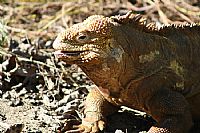 Isabela, Land Iguana |
After cruising all night, we drop anchor off of Isabela Island around 6:30am. From our stateroom on Vista Deck (400 series), the anchoring procedure will never go unnoticed as the clatter of the chain reverberates through the metal hull of the ship. If you weren't awake by anchoring time - it's doubtful that you'll sleep through it.
The west coast of Isabela is another in the itinerary of the HSM Beagle. After a quick breakfast at the buffet at Darwin's we're off for the first high intensity excursion of the day to Urbina Bay. The beach is small and steep, but isn't particularly tricky for this wet landing. The remainder of the hike beyond the beach is through scrub vegetation, with mostly sand and some gravel on the path. Along this 1 mile hike we sight some of the largest land iguanas that we've seen along with a small, young tortoise. Yellow jacket wasps are a nuisance on Isabela, being attracted to the small yellow flowers of one of the indigenous trees. Our guide recommended against any yellow color clothes or hats and insect repellant if you'd like. We did have one member of our group get a nasty wasp sting. As with yesterday, swimming and snorkeling are available from the beach after our hike
Returning to the ship around noon, we enjoy the Ecuadorian Lunch Buffet on the outer deck at Beagle's Grill and in Darwin's Restaurant. During lunch, we cruise along the coast of Isabela through the narrow channel formed by very close Fernandina Island in search of whales and dolphins.
The afternoon high intensity excursion is a wet landing (because of low tide) at Espinoza Point on Fernandina. Between our landing area and the main island there is a huge colony of marine iguanas that have hauled up onto the warm black rocks. We literally have to weave our way through their areas and their "spitting" the seawater from their nostrils. Further inland, we explore some of the tide pools finding the ever-present sea lions and sally crabs and our first glimpse of the Flightless Cormorant. These duck-like birds have lost the use of the wings that brought them to the islands thousands of years ago, but in exchange have gained the ability for swift underwater swimming. At the edge of a small tide pool area we watch a sea turtle pulling itself off the sand into the incoming tide - an event that our guide said she'd not experienced in over 3 years.
We make a long hike inland along a fault cracked lava field. Several of the fault crevasses are wide enough to require a small jump to clear. Nearly the entire area of this expedition is broken lava rock, making this a difficult excursion for those with mobility issues. One member of our group and a member of another group took a fall on the unforgiving rock - this excursion requires sure footing, good shoes and good mobility.
Back on board, we enjoy the "Sounds of Silence" dinner that is served under the stars on the rear portions of decks 4 & 5. The chefs have prepared a feast of local favorites and some more traditional international fare. There are several kinds of meats (chicken, sausage, beef) being grilled. Everyone enjoys this dinner - and in my opinion it was the culinary highlight of the week. It is also the first time that the upper level Blue Finch Bar has been opened. This is a great space, but doesn't seem to open due to either staffing issues or lack of interest from the passengers.
From the western side of Isabela, tonight we again will cross into and out of the northern hemisphere enroute to Santagio Island located just north west of Santa Cruz.



